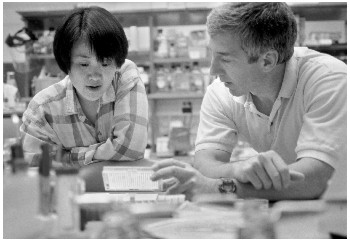
Ray Mernaugh, Ph.D., and Dr. Xiaohong Wang examine results obtained using recombinant antibodies on synthetic peptides. (photo by Dana Johnson)
Antibodies help narrow search for cancer clues
Scientists tracking the cellular culprits that contribute to cancer can turn to colleague Ray Mernaugh, Ph.D., and his staff for tailor-made bloodhounds for their search.
Mernaugh directs the Molecular Recognition Unit of the E. Bronson Ingram Cancer Center at Vanderbilt University. The unit is one of very few academic-based laboratories to provide a full-range of specially created antibodies for use in research, diagnostics or therapeutics. It is one of more than a dozen "shared resources" in the Vanderbilt-Ingram Cancer Center that offer specialized equipment and expertise that individual researchers or departments could not afford on their own.
Antibodies are the immune system's scouts for invaders. They are created by an animal's B cells in response to an antigen, any substance that the body sees as "foreign."
In cancer research, antibodies can be used to target proteins that appear to play a role in the development or progression of tumors. Tagged with fluorescent dyes or other means to permit them to be seen microscopically, these antibodies can help scientists locate suspect proteins and observe their behavior and their interactions with other accomplices in the disease process.
"That helps the researchers determine what the protein is, where it is, when it is turned on and off, how it interacts with other things in the cell," Mernaugh explained. "If they can identify those things, perhaps they can make a drug that will stop it. Having these tailor-made antibodies helps them get where they need to go quickly."
In the future, antibodies also could be used to diagnose or treat cancer by tracking down malignant cells in the body and carrying a weapon to kill them, Mernaugh said.
Creation of these antibodies using traditional "polyclonal" or "monoclonal" methods is time-consuming and does not always produce sure results. Researchers prompt an immune response by injecting an animal with an antigen. They then harvest the antibodies directly from the animal's blood or remove the antibody-producing "B cells" from the animal's spleen to generate monoclonal antibody-producing hybridomas. This process takes an average of four to six months — if the antigen was "foreign enough" to cause antibody-production in the first place.
Mernaugh's group is using a technique to overcome these limitations. From antibody-making genes from a large pool of B cells, they have genetically engineered a library of viruses that display different antibodies on their tips. In a thimble-sized vial, the researchers store antibody-displaying viruses that can recognize between two and three billion different antigens.
Researchers who have identified a cancer-related protein can bring the protein or a portion of it (a peptide) to the Molecular Recognition Unit, where the team goes through a complicated process to select one of these "recombinant" antibodies from the library. These antibodies, which behave like typical monoclonal antibodies, can be obtained in as little as five days.
In addition to producing polyclonal, monoclonal and recombinant antibodies, the facility also includes a special piece of equipment, called the BIAcore, that allows scientists to view — in real-time — how strongly and for how long two molecules interact with each other. Again, the goal is to "see" what's going on inside the cells as cancer develops and progresses, with an ultimate aim of interfering in that process.
Mernaugh's work has attracted a "Discovery Grant" from the VICC to help him and his colleagues — Dr. Bob Coffey, David Threadgill, Ph.D., and Jim Tam, Ph.D. — develop ways to find the right antibodies in the library even more quickly and more effectively. Threadgill and Coffey use "microarray" laser technology to identify genes that are active in cancer but not in normal cells. Tam makes synthetic peptides, which correspond to the proteins produced by these genes, that Mernaugh then uses to tailor the antibodies.
The Discovery Grant will fund research to determine how to shape the peptide and orient it to increase the odds that its targeting antibody, found in the library, will recognize the native protein. "Sometimes we can't find an antibody. We believe it's in there," Mernaugh said, pointing to the vial containing the antibody library, "but perhaps we don't have the right configuration or orientation so that the antibody recognizes it."
The grant is provided through an innovative VICC program in which individual donors or groups can raise $30,000 to fund specific projects. The goal is to provide seed money for novel research with the hopes that as more proof is obtained, the work is will be competitive for other research grants.
Mernaugh's grant was funded by David Sampsell, a member of the Imagine A World Without Cancer Campaign Committee and longtime friend of the late Bronson Ingram, for whom the Cancer Center is named. "His death (from cancer) was tragic and hit me very personally," said Sampsell, retired vice president for corporate development at Ingram Industries. "This gift is part of my revenge."













